Simply put: You can’t have a business without sales.
And anyone who’s experienced low or inconsistent sales has felt how threatening it is to your company’s very existence.
Whether you’re running an established company or a startup, you need a repeatable, well-structured sales process to ensure your sales grow and multiply.
Having a clearly defined sales process gives you the direction to take from prospecting to closing. It’s a type of “blueprint” that every rep can use to turn leads into customers.
Companies that map out and perfect their sales processes are the ones that successfully keep their operations afloat.
In fact, research has shown that a structured sales process is a key differentiator between high-performing and underperforming organizations.
You should absolutely start building a sales process if you don’t already have one for your company.
Seriously. Do it.
If you’re feeling overwhelmed and not quite sure where to start, fret not. In this post, you’ll learn what a sales process is as well as some actionable steps to start building your own.
Post Contents
Sales Process Definition
A company’s sales process can take many forms, but they all fit a similar mold that strives toward the same purpose:
Every sales process is a set of steps geared toward standardizing how your sales team sells. It guides every stage of the sales cycle – from prospecting to nurturing customer relationships – so that each rep can repeat your best results over and over.
You can think of it as a framework for how all of your company’s leads travel through your sales funnel. It’s an iterative process, meaning that it should change and evolve over time with your company and goals.
The best sales process is broken down based on the four sales stages of the funnel:
- Prospecting
- Presentation
- Closing
- Follow up
Within each stage, your sales process should include specific, actionable tasks that each rep must complete.
Benefits of a Sales Process
Having a strong sales process has numerous benefits for your brand. Let’s discuss a few.
- Better Lead Qualifying
A comprehensive sales process can help your sales team focus on the key factors that make your best leads so great.
When members of your team are better able to identify quality leads, they’ll naturally waste less time trying to build relationships with leads that don’t end up working out in the long run.
- Faster Sales Cycles
When it’s built right, your sales process will reduce – or even eliminate – a lot of the friction that your team experiences when they’re moving leads down your sales funnel.
By avoiding common pitfalls, improving communication, and streamlining the steps, your team can close deals more quickly and efficiently.
- More Predictable Results
The whole point of a sales process is to take out as much guesswork as possible.
As you continue to design, test, and tweak your sales process, you’ll find that your outcomes are more steady and predictable.
- Better Customer Relationships
Not only will your team be landing more deals, but those new customers will also have better relationships with your brand.
That’s because a strong sales process ensures that customers’ concerns are addressed, and they’re given just the right amount of support and attention during the sales cycle.
This, in turn, builds more trust and loyalty for your brand, which can ultimately translate to a higher customer lifetime value and more revenue per customer.
Creating Your Own Sales Process: The 4 Sales Process Stages
The first step to building a sales process is defining your sales stages. These are the steps your leads go through in their sales cycle:
While the number of sales process steps vary from business to business, the basic idea is the same: to help reps understand what actions are needed to move leads along the path to purchase.
Even though your sales stages should be tailored to your specific organization and reps, these are the general steps we recommend using for your sales process.
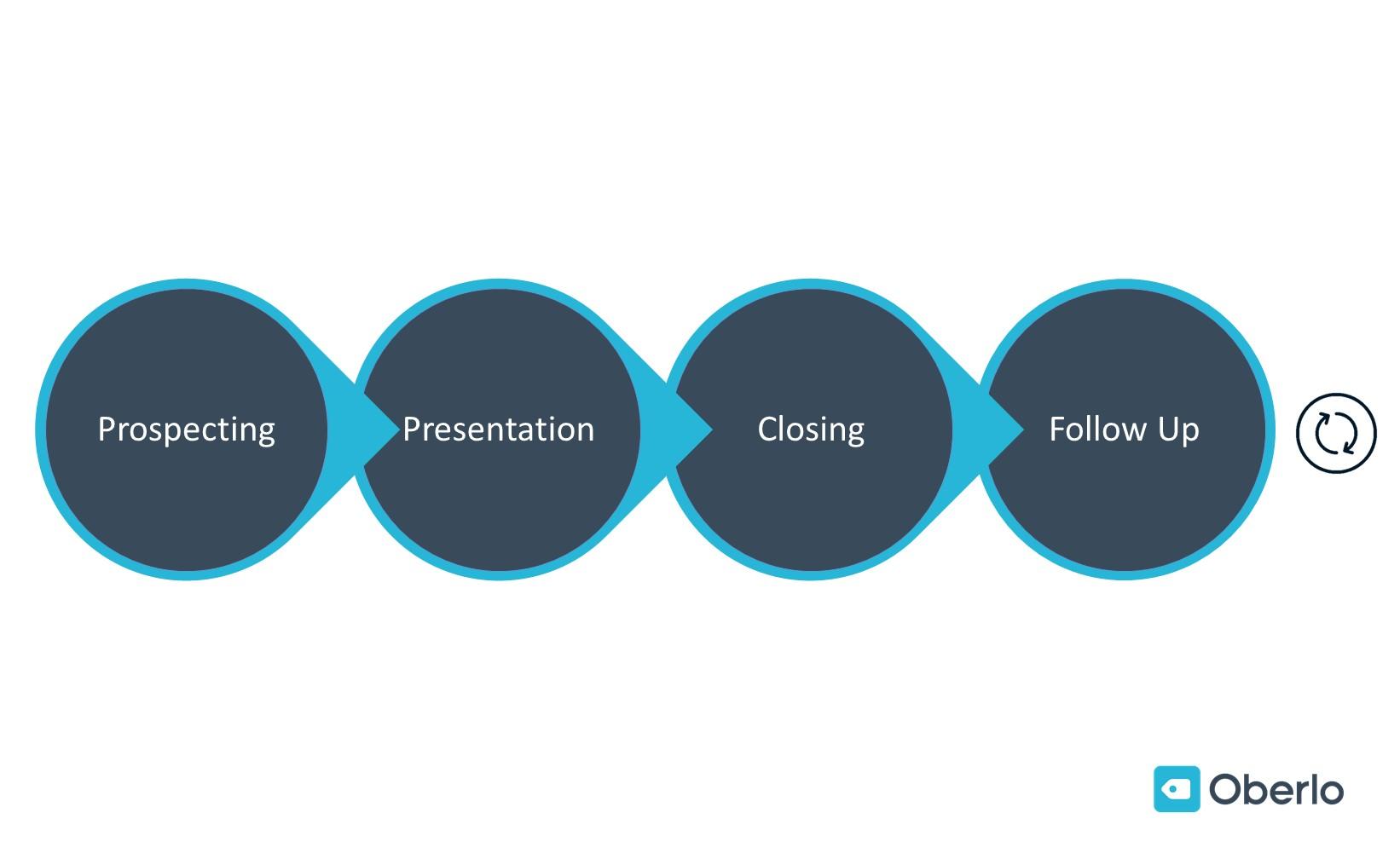
1. Prospecting
Sales prospecting is the process of figuring out if a lead is going to become a paying customer. It helps members of your team spend their time more effectively.
Rather than filling your sales pipeline with as many contacts as possible, you want to refine your prospecting methods early on – pitching only the prospects that fit your target criteria.
But where do you start? How do you actually identify if a prospect is ready to give you their business?
If you really want to do sales prospecting right, here are the keys:
Build an Ideal Customer Profile
An ideal customer profile (ICP) is a reflection of your prospective buyer based on key attributes like gender, monthly earnings, profession, industry size, and factors that influence their purchase decision.
The best way to create an ICP is to identify and interview people who are getting immense value from your product or service. What do you already know about your top customers? List down their:
- Age
- Gender
- Income range
- Company
- Industry
- Location
- Pain points
- Channel preferences
- Business objectives
As you’re writing down these attributes, you’ll notice you have more data about some than others. That’s where online research can be a blessing in disguise.
For instance, you can get information about a customer’s position, company, and location directly from LinkedIn.
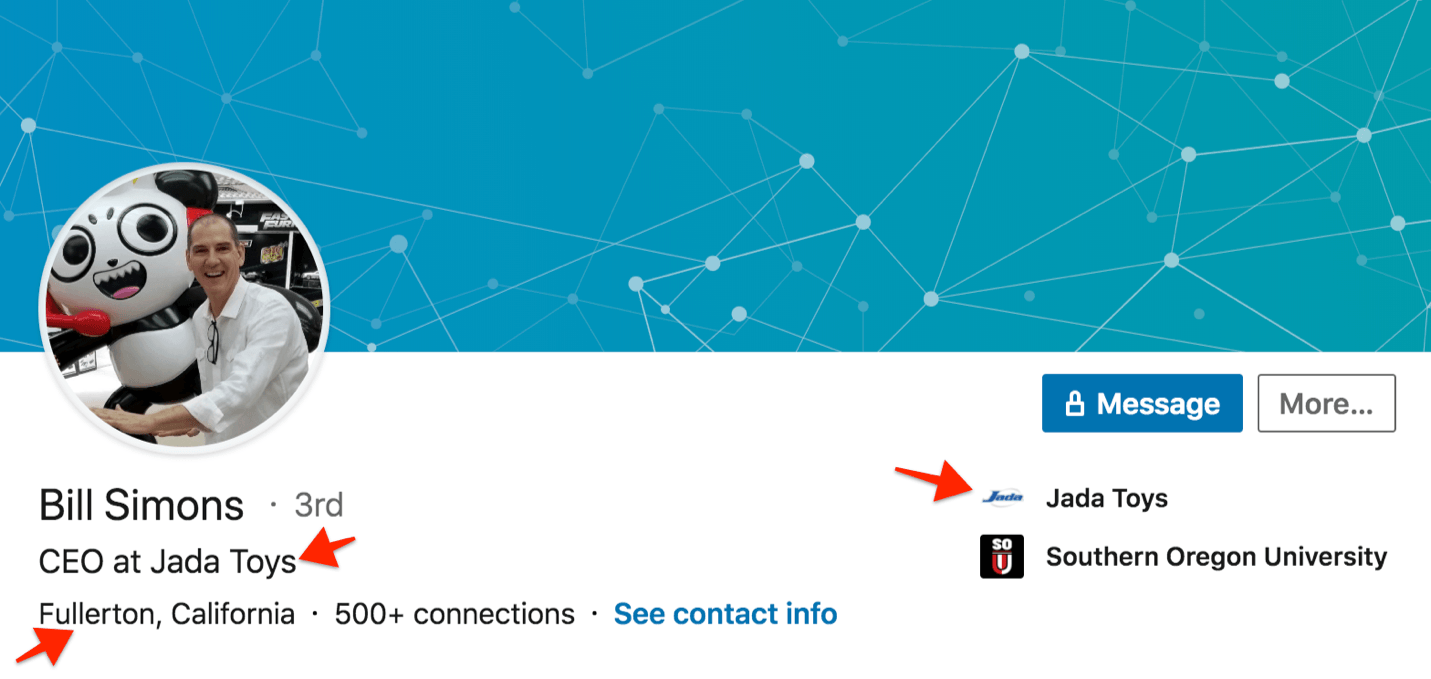
Crunchbase is another useful resource for sourcing information on a customer’s company size, website address, and other data points that influence prospecting. All you need to do is enter a company name, and it’ll provide you with all of those details.

The right research will increase your chances of building a successful sales process. Get familiar with your customers, create an ICP, and screen your prospects based on this benchmark to ensure your team is allocating resources toward high-value leads.
Need help creating an ICP? Use this free template to help you out.
Ask for Referrals
There’s no warmer prospect than one that’s generated through word of mouth. If someone refers you a customer, they’ve completely checked prospecting off of your list.
Of course, referrals are easier said than done. What if you don’t have the resources or budget to offer a referral bonus? What if you’re just a small company? Is referral prospecting out of your reach?
Fortunately, it’s not. You can still get loads of referrals by offering exceptional customer service, using influencer marketing, and making your product experience shareable.
For more ideas on how to make existing clients rave about you in front of others, check out our Ultimate Guide to Referral Marketing.
Have Red-Hot Leads Delivered to Your Inbox
With a sales prospecting tool, you can automate the process of researching and qualifying prospects.
While there are several tools that can help you with prospecting, LeadSift is one of the best.
LeadSift states that only 3 percent of leads are actually interested in becoming a customer. So, it sifts away people who aren’t looking to buy and leaves you with contacts who have their wallets ready.
The best part? The tool generates some of the prospects by looking up your competitors.
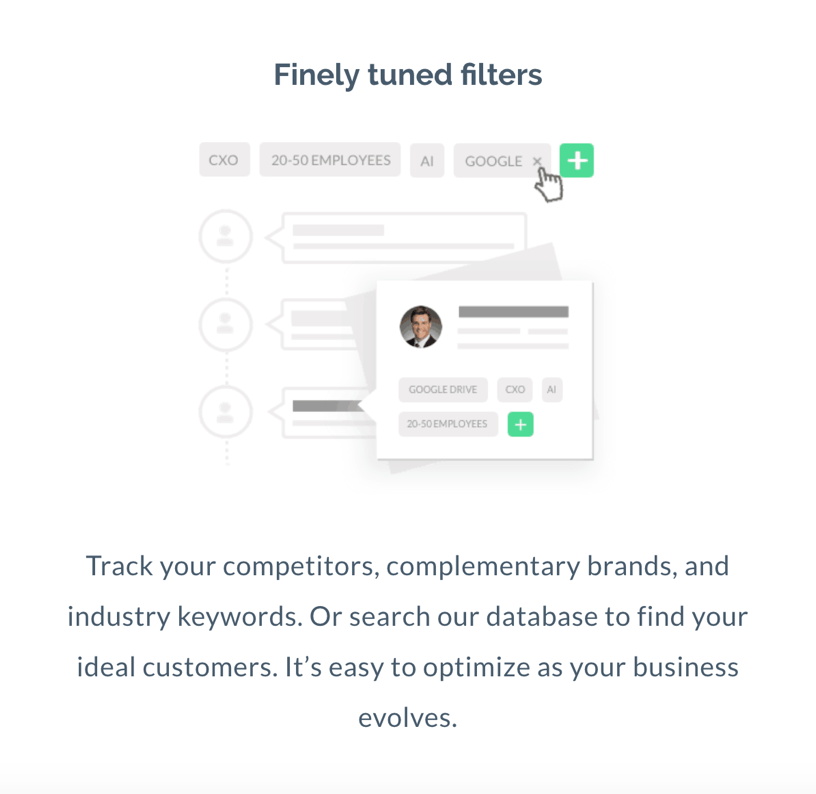
Now that you have these sales prospecting tips in your arsenal, next comes the presentation!
2. Presentation
Your sales presentation is the next key phase in your sales process. This can take place online or in-person. The best in the business know that, when used correctly, sales presentations are a high-converting tool.
Impress with a problem-focused presentation.
Start with an evocative description of the prospect’s pain point, show an enviable world where they’re living problem-free, then explain how to get there using your solution.
Chris Orlob of conversation intelligence company Gong offers a great explanation of why you need to dive into the pain before you can enjoy the gain.
By digging into your prospect’s problems today – Point A in the graph below – you facilitate self-discovery and make your solution seem a lot more valuable.

A lot of companies are already using this strategy to augment their sales processes. Here’s one example:
Vaultastic’s slides first talk about the fragmented data in email inboxes and then touch upon the pain point of financial services companies. After Slide 15, they move toward the solution and detail how they can help derive insights from legacy email data.
In addition to highlighting your prospects’ problems, use the following tips to spruce up your sales presentations.
Use Visuals Where Possible
A picture is more effective than a thousand words, and this is very much the case for sales presentations.
Instead of bombarding your audience with heaps of text, use visuals to help them interpret.
Use diagrams to illustrate processes. Use graphs to depict numerical information. Use photos to show a place, object, or person.
If you need a quick method for creating visuals, use Canva. It’s a tool that lets you create all sorts of designs.
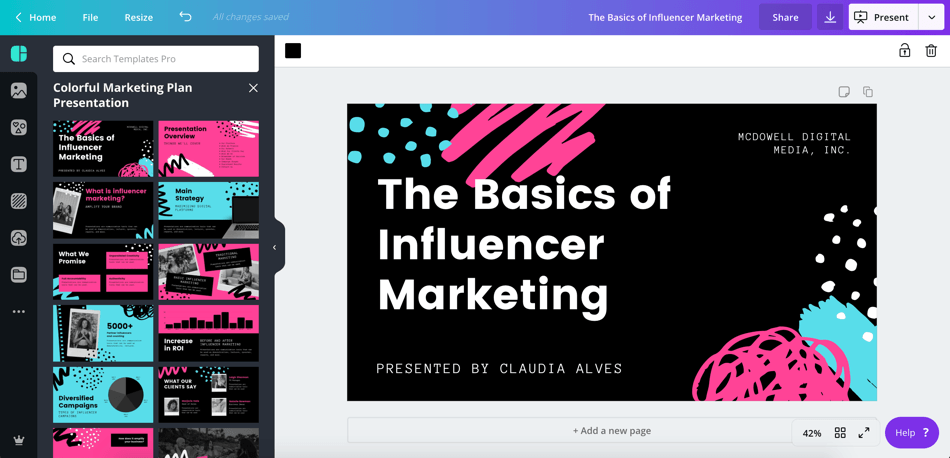
Use Social Proof to Your Advantage
In layman’s terms, social proof is providing prospects with evidence of your solution’s popularity or success.
For the people seeing your presentation who don’t convert into immediate buyers, you need to demonstrate that your company actually lives up to your claims. The easiest way to do this is to include testimonial pull-quotes and logos of your highest-profile customers in your presentation.
Remember to use real companies, real names, and real-life examples. Nothing is more authentic than this.
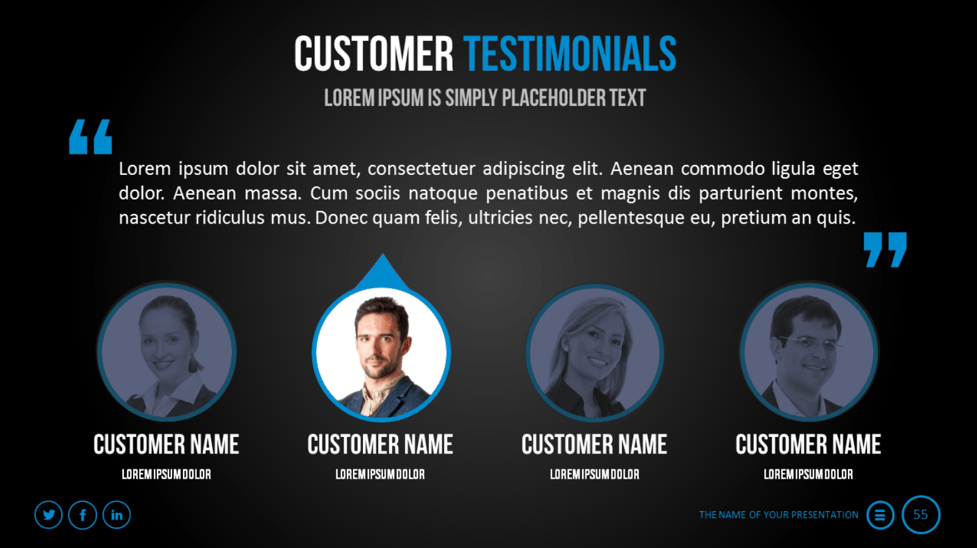
For more examples and ideas, read “Social Proof: What It Is and Why It’s Great for Marketing.”
Equip Yourself With the Necessary Tools
It’s also crucial to download the right tools to share your presentation if it needs to be delivered remotely.
The most important is a video conferencing tool. GoToMeeting has several great reviews, and it’s also popular for its consistent audio and video quality.
Another useful tool is Zentation. Presentations created with this software become webcasts, virtual events, and webinars for customers and prospects – all valuable collateral for sales and marketing.
Before scheduling a meeting with your prospect, download these presentation tools to ensure smooth delivery and timeliness.
Once you’ve given the presentation, it’s time to seal the deal.
3. Closing
Now, the moment of truth.
The closing stage of the sales process is when you address your prospect’s concerns and ask them to become your customer.
At this point, you should try to identify and resolve any concerns that arise after the presentation. A common concern often relates to the competition.
Maybe your product or service is pricier than your competitors. Perhaps it’s better in terms of quality. Either way, try to take the price out of the equation if that’s what your prospects keep harping on.
A great way to make your value proposition stand out is to set up a competitive matrix to show off to your prospects. The matrix will highlight where your competitors fall short and how they compare when put side-by-side.
Here’s one example from Campaign Monitor. Anyone shopping for an email marketing solution should be able to identify the tool’s strengths compared to its competitors.
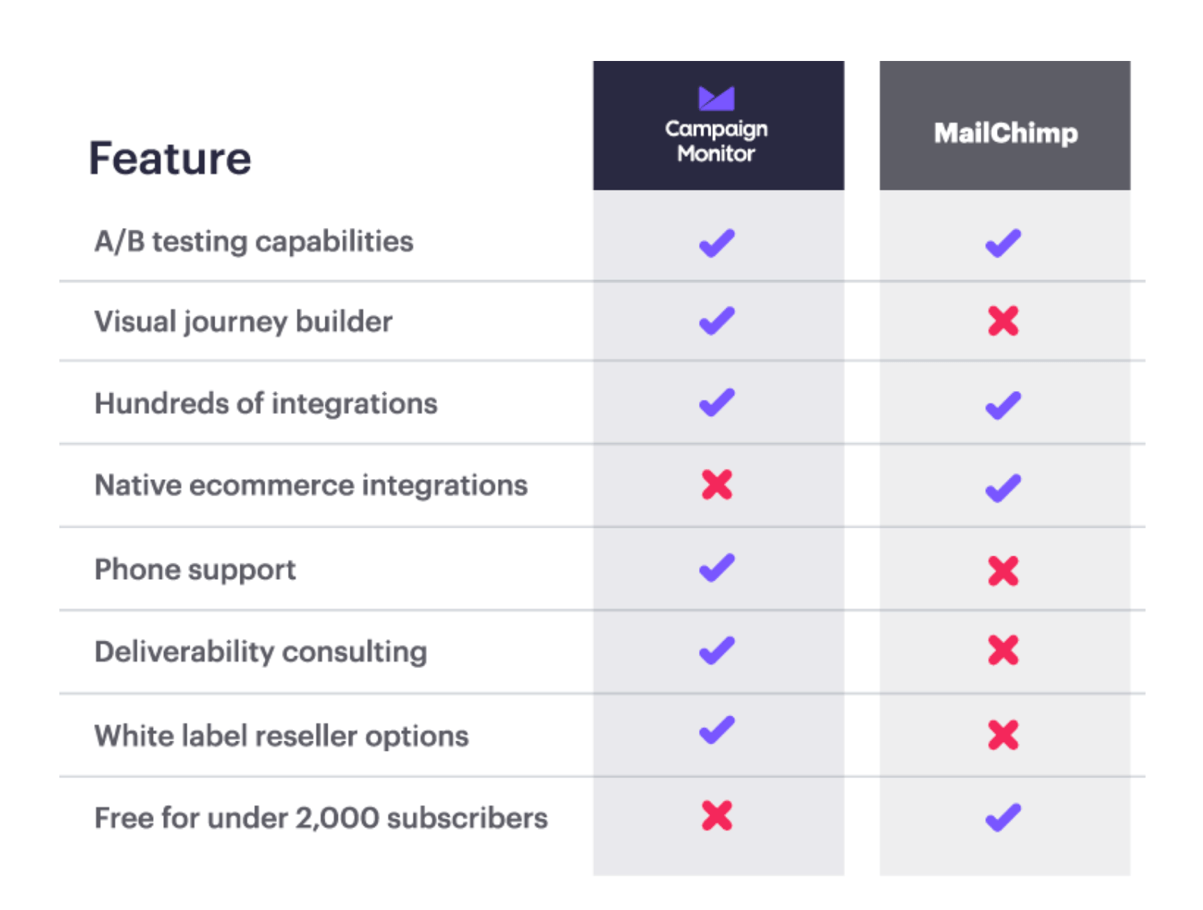
Comparisons like these are instrumental for explaining why your solution is better than the rest at a glance.
After you’ve addressed the main concerns, it’s time to ask for the prospect’s signature.
Depending on the nature of your business, you might try one of these three closing techniques.
Limited Time Close
When you sense that a prospect is on the fence, you can use this technique as a way to encourage immediate action. You might say something like:
“We’re offering free upgrades to all subscribers until Friday. Why don’t you sign up today, so you don’t miss out on this great opportunity?”
or
“Just remember, this offer is only valid for the next 24 hours.”
Basic Package Close
If you come across a prospect who’s hesitant to fully commit, consider offering a basic package or version of your product or service.
Explain that they’re still getting a great solution, although not what they could get if they went with your initial recommendation. You can say something like:
“OK, how about we sign you up for the basic plan instead? You’ll still be able to take advantage of the core features. That said, most of our clients are on the premium package because it has additional features. What do you think?”
Assisted Close
If you consider your lead qualified and they’ve attended your presentation, you can get down to business and ask what is It you can do to make them take action. Below are a few recommendations on what to say in assisted close:
“Well, it seems like you’re satisfied with everything we’ve discussed – how about I email you the contract?”
or
“What do you need from me to sign and return this contract today?”
Ideally, all closing efforts should end with a sale. However, this isn’t always the outcome. Regardless of the result, the key to staying in the game is a follow up.
4. Follow up
Did you know that 80 percent of sales take five follow ups to close?
That means a good portion of closing prospects depends on the steps you take after you’ve given them your offer. Find ways to keep in touch without irritating them. Below are a few tips.
Go Omnichannel
Yes, email is the most popular way to follow up with prospects. But that doesn’t mean other channels aren’t worth your time.
Perhaps your prospects spend half of their day on Facebook. Maybe LinkedIn is their go-to platform for researching companies. If your audiences prefer to use certain platforms, you should be engaging them there.
Adopt an omnichannel approach that includes social media, email, phone, live chat, and in-person meetings to increase your chances of landing the sale.

Share Something Valuable
When it comes to the content of the follow up, anything you think will strengthen your case while providing value to your prospects works. You could do anything from the following:
- Share some trends and industry gossip
- Introduce prospects to an influencer
- Recommend a service, tool, or piece of software
- Refer a useful business contact
Whenever you think of a follow up method for a prospect, write it down somewhere because you could take the exact same approach when other similar prospects enter your sales process. Like this, you can build an effective database of follow up items that you can use time and time again.
Schedule Your Follow ups
OK, so you know why following up is an essential aspect of a sales process, and have a rough idea of what content and approach to use.
Before you begin, though, you need to set yourself up for optimal success. The key? Automation.
You can automate some of the moving parts of this sales process stage by scheduling your follow ups. It can be done regardless of the channel, as scheduling tools exist for almost every platform.
If you’re sending follow up emails, use Drip to create a lead nurturing campaign. For social media, use HootSuite to schedule follow up messages. Calls and meetings can be scheduled using Google Calendar or another similar tool.

If you do everything right, nothing else should prevent you from making a sale.
Mapping Is Key to Making Your Process Work
Now that you’ve identified your sales process stages and tasks, it’s time to document them and share them with your team.
While it’s true that your reps can go out and close deals without a well-structured process, it’s unlikely that they’ll be able to scale your sales to their full potential.
That’s where a sales process map comes in.
With a sales process map, you lock down the steps. You create a resource that every salesperson can access and leverage no matter their level of seniority or where the prospect they’re communicating with is in the customer journey.
The best structure for a sales process map involves arranging the stages into vertical columns. The top of every column contains the name of the stage, and the action steps are mentioned below.
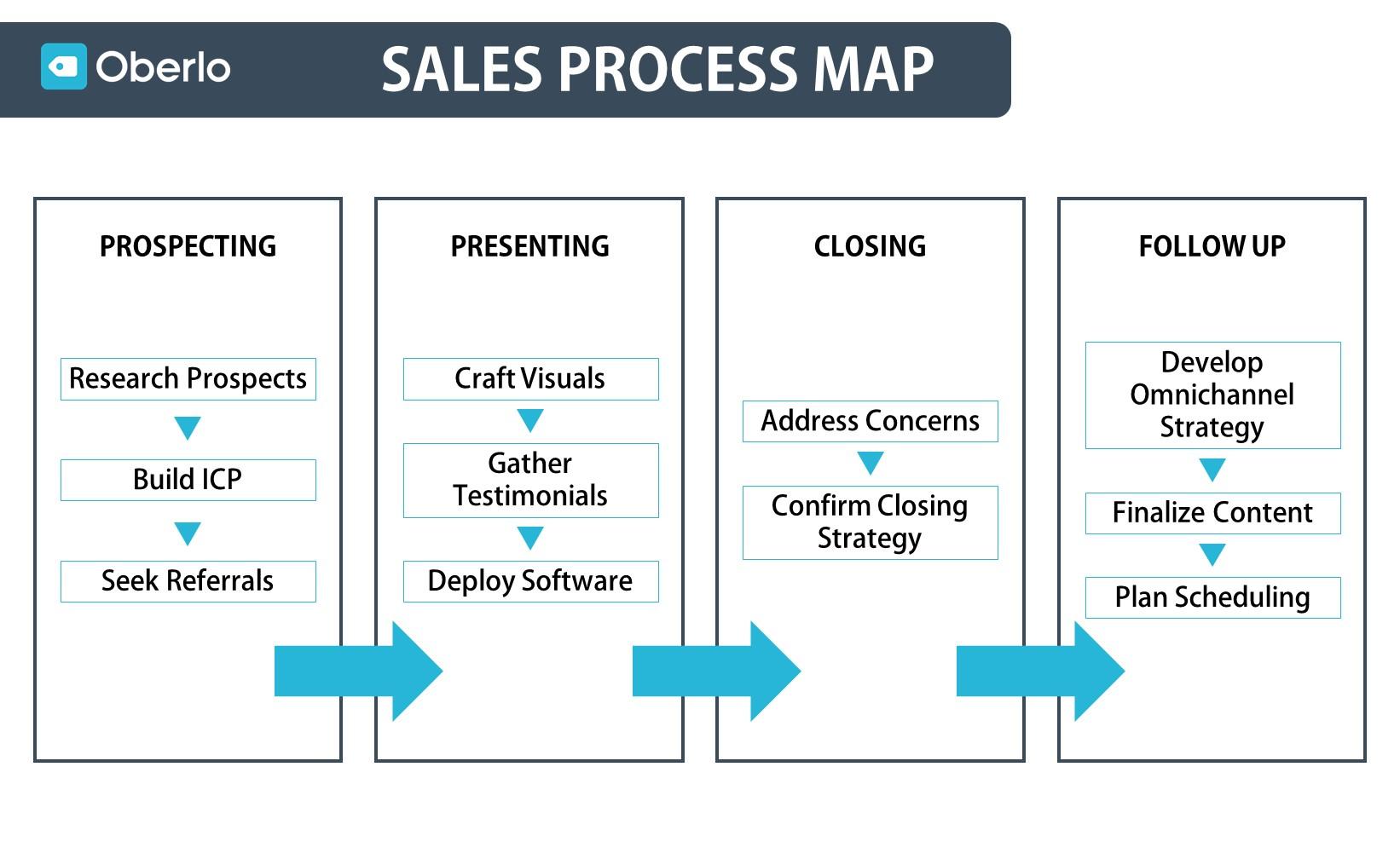
Once developed, shared, and implemented across your company, a sales process map will cut short the time it takes to move prospects through the funnel.
Final Thoughts
The best sales process is dynamic.
It can be revised or updated to reflect the current size of your sales force, your company specifics, and your prospects’ changing preferences.
Don’t get caught up in trying to create the perfect sales process right off the bat. Evaluate frequently, and be prepared for the occasional touch-ups.
Have you created a sales process for your company? What does yours look like? Let us know in the comments section below.
